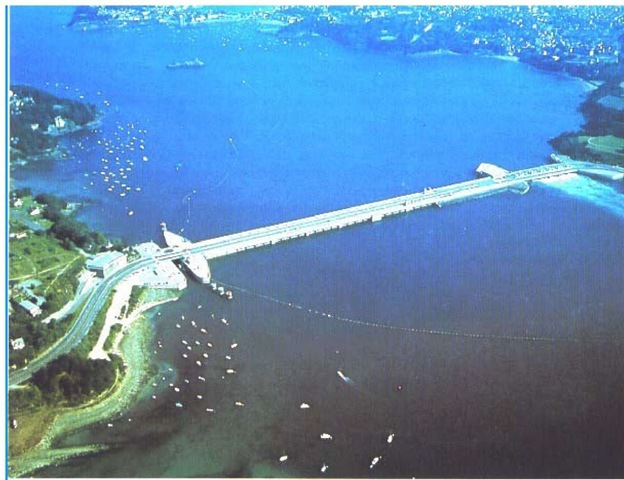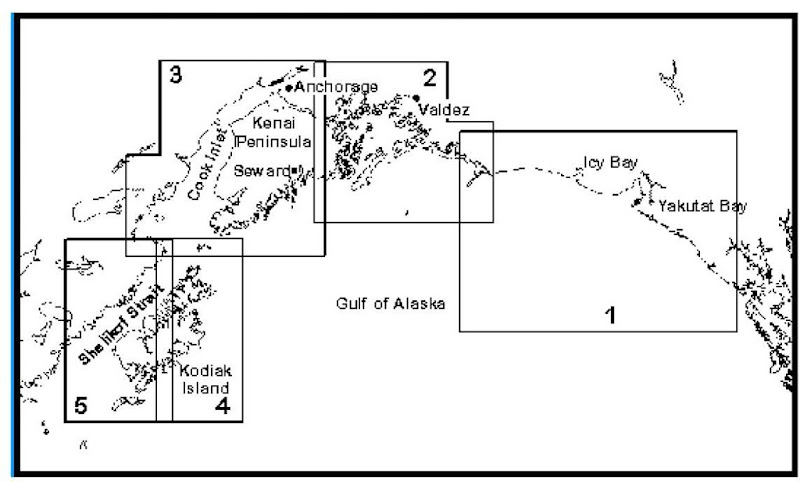Energy extracted proportional to the volume of water and the temperature it drops.
Principal energy loss is when the warmer water meets the cooler water in the condenser.
Review of OTEC (Ocean Thermal Energy Conversion)
• Thermal gradients of greater than 22 C can be exploited and used as a heat engine
• Energy is derived from cooling warm surface water to the temperature of the water at approximately 500-1000 feet depth.
• The maximum surface temperature of ocean water is 25 C and its minimum value is of course 0 C
• efficiency is then 1 -(273+0)^273+25) = 1 – 273/298 = 7%
• Energy is derived from the cooling water via transfer to a working fluid such as ammonia which when mixed with warm water vaporizes to steam and powers a turbine
• Ammonia returns (condenses) to liquid when mixed with cooler water at depth and then the cycle repeats itself
• Since the volume of water in the oceans is huge, the capacity in just the Gulf Coast Waters alone is several 10′s of Giga
More on OTEC Hawaii Facility
Ocean Power also comes in 2 other forms:
- Tidal Energy
- Current Flow Energy
The ocean is a huge reservoir for storing the energy of the sun that is incident on the earth. How huge is huge?
Incident flux on ocean surface area is 1017 Watts or 0.1 Billion Billion Watts (its a large number)
The oceans are a huge heat engine. Temperature differences, caused by differences in insolation both in latitude and in depth.
Equatorial waters warmer than higher latitude waters o surface layers warmer than deeper layers o This sets up an enormous circulation network
Major currents are shaped by:
- Temperature differences (driven mostly by tilt of earth’s axis)
- Prevailing wind patterns interacting with the surface waters (again driven mostly by tilt of earth’s axis) o the rotation of the earth the Coriolis Force
- shorelines of continental masses
Tapping the Current for Energy:
- Gulf current has 1000 times the flow of the Mississippi River(!)
- Current averages about 5 mph
- Density of water is higher as well
- Its always there – no intermittency problem need for energy storage
- Build Turbines for underwater use
- Anchor a foundation to the ocean floor
- hundreds of miles long rigged with turbines
- cables on ocean floor to shore deliver the electricity
- An engineering challenge but there are few bad side effects from producing energy this way
- Obviously the capital costs are huge in this case but this does represent a Large Scale Solution
Tidal Energy from the Ocean
- Extracts energy from the kinetic energy of the earth-moon-sun system.
- Variations in water level along coastlines can be used to drive turbines
- technology is the same as low-head hydro power
- Vertical tides on US coast range from 2 feet in Florida to more than 18 feet in Maine
To enhance efficiency of turbines driven by tidal currents, it is desireable to build a damlike structure across the mouth of a tidal basin in order to direct the flow to a turbine
Turbines designed for work at both high and low tide (inflow or outflow)
Intermittent tidal flow is major problem. Tidal facility produces about 1/3 the electrical energy of a hydro facility of the same peak capacity
Two tidal plants in the world:
1 MW facility on the White Sea in Russia (1969) o 240-MW on the Ranee River, St. Malo France (1967) B^Thas 750 meter long dike to impound tides that can be as high as 13 meters (!)
Proposed New Facilities:
- Phillipines
- Apsley Strait, Australia
- A serious commercial venture
- Large Scale production in the UK
- Potential Sites in the US
- Alaska ( Cook Inlet)
Bay of Funday (US-Canadian Border; NE Coast of US) most favorable site in the World would produce about 30,000 MW in total (1/2 for the US)
- A 20 MW demonstration plant has been built here
- Locally (New England) this is a potential important source of power but on national scale is just a few percent of our (insatiable) need for power
Bottom Line: There aren’t many favorable sites in the world for tidal power and the estimated capacity is 50 times smaller than the world’s hydroelectric power capacity.


![tmp87-63_thumb[1] tmp87-63_thumb[1]](http://lh4.ggpht.com/_LenCZlyza20/TRK9dwv64jI/AAAAAAAAGJQ/MYYxcsrkios/tmp8763_thumb1_thumb1.jpg?imgmax=800)
